Related Research Articles

The Mikoyan-Gurevich I-270 was a response to a Soviet Air Forces requirement in 1945 for a rocket-powered interceptor aircraft for the point-defence role. In concept and basic configuration, it was related to the early Korolyov RP-318 rocket-powered aircraft which was developed in 1936 and first flew February 20, 1940, and the more recent Bereznyak-Isayev BI-1 Soviet design. Only two prototypes were built, both of which were destroyed in crashes, leading to the cancellation of the project.
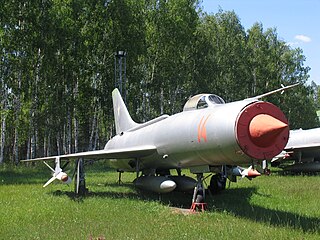
The Sukhoi Su-11 was an interceptor aircraft used by the Soviet Union during the Cold War.
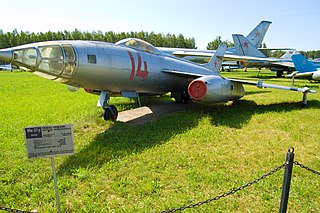
The Yakovlev Yak-27 was a family of Soviet supersonic aircraft developed in 1958 from the Yak-121 prototype. The most built variant was the tactical reconnaissance Yak-27R.

The Yakovlev Yak-15 was a first-generation Soviet turbojet fighter developed by the Yakovlev design bureau (OKB) immediately after World War II. The main fuselage was that of Yakovlev Yak-3 piston-engine fighter modified to mount a reverse-engineered German Junkers Jumo 004 engine. The Yak-15 and the Swedish Saab 21R were the only two jets to be successfully converted from piston-power to enter production. 280 aircraft were built in 1947. Although nominally a fighter, it was mainly used to qualify piston-engine-experienced pilots to fly jets.

The Yakovlev Yak-25 was a Soviet military aircraft, an early turbojet-powered fighter aircraft designed by the Yakovlev OKB. The designation was later reused for a different interceptor design. Tasked by the Council of Ministers in a directive issued on 11 March 1947, with producing a straight winged fighter similar to the earlier Yak-19, but powered by a Rolls-Royce Derwent V, OKB-115 swiftly produced the Yak-25, which blazed several trails as the first Soviet fighter with a fully pressurised cockpit, air conditioning, jettisonable canopy, and hydraulic airbrakes on the fuselage amongst other innovations.
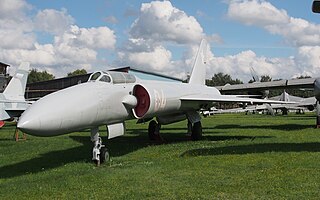
The Lavochkin La-250 "Anakonda" was a high-altitude interceptor aircraft prototype developed in the Soviet Union by the Lavochkin design bureau in the 1950s. Its nickname "Anaconda" was invented during the flight test and referred to both the elongated body shape as well as the relatively critical flight characteristics of the machine.

The Yakovlev Yak-30 was an experimental Soviet interceptor from the late 1940s. Derived from the Yak-25, from which it differed primarily in having wings sweptback 35° at quarter chord, the Yak-30 retained the fuselage, tail surfaces and undercarriage of the earlier fighter.

The Sukhoi Su-6 was a Soviet ground-attack aircraft developed during World War II. The mixed-power high-altitude interceptor Su-7 was based on the single-seat Su-6 prototype.
The Sukhoi Su-10 or Izdeliye Ye was a Soviet turbojet-powered bomber aircraft built shortly after World War II.
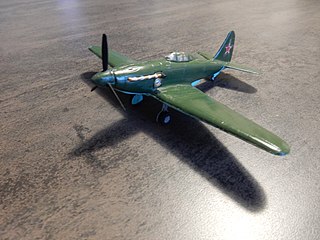
The Sukhoi Su-1 or I-330 was a prototype Soviet high-altitude fighter aircraft built at the beginning of World War II. An improved version, designated Su-3 (I-360), was also built and tested the following year. Neither version was mass-produced.

The Sukhoi Su-15 was a prototype Soviet all-weather interceptor which never reached production.
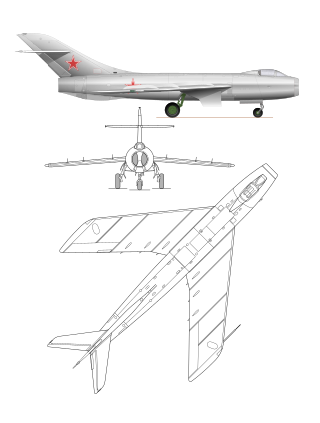
The Sukhoi Su-17 was a prototype Soviet fighter. The name was later reused for an entirely different fighter-bomber, see Sukhoi Su-17.

The Ilyushin Il-22, USAF/DOD designation Type 10, was the first Soviet jet-engined bomber to fly. It used four Lyulka TR-1 turbojets carried on short horizontal pylons ahead and below the wing. The engines did not meet their designed thrust ratings and their fuel consumption was higher than planned. These problems meant that the aircraft could not reach its required performance and it was cancelled on 22 September 1947.
The Mikoyan-Gurevich I-75 was the final design of a series of three experimental swept-wing interceptors developed in the Soviet Union in the mid-late 1950s by the Mikoyan-Gurevich design bureau from their Mikoyan-Gurevich I-3 airframe. All the aircraft in the I-3 program were affected by delays in the development of the Klimov VK-3 turbojet engine, its cancellation and ultimate replacement by the Lyulka AL-7F turbojet engine.

The Mikoyan-Gurevich Ye-150 family was a series of prototype interceptor aircraft designed and built by the Mikoyan-Gurevich design bureau in the Soviet Union from 1955.
The Yakovlev AIR-6 was a Soviet light utility aircraft of the 1930s. It was a single-engined high-wing monoplane designed by Alexander Sergeyevich Yakovlev, with 128 being built.
The Beriev S-13 was a Soviet reverse-engineered copy of the Lockheed U-2C, developed in the Soviet Union in the early 1960s.
The Yakovlev Ya-21,, was a single-seat high-speed sport aircraft / fighter-trainer designed and built in the Soviet Union in the late 1930s.
The Tupolev Samolyot 135 was a designation that was used for two different strategic bomber projects in the Soviet Union in the late 1950s and early 1960s, neither of which progressed beyond the drawing board.
The Ilyushin Il-26 was a late 1940s project for a strategic heavy bomber by the Ilyushin Design Bureau. There were a variety of alternative engines proposed for the Il-26, including the 3,400 kW (4,500 hp) Shvetsov ASh-2TK piston engine and 4,500 kW (6,000 hp) Yakovlev M-501 diesel engine. The specifications varied according to the number and type of engines proposed.
References
- 1 2 3 Gordon, Yefim; Dmitry; Sergey Komissarov (2005). OKB Yakovlev . Hinkley: Midland Publishing. p. 233. ISBN 1-85780-203-9.